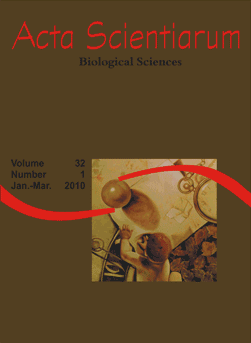<b>Assessment of a multi-fleet fishery for gray triggerfish (<em>Balistes capriscus</em>) in São Paulo State</b> - DOI: 10.4025/actascibiolsci.v32i1.4772
Keywords:
fishery, multifleet, grey triggerfish, Balistes capriscus, Southeast-South, Brazil
Abstract
The gray triggerfish (Balistes capriscus) is an important fisheries resource in São Paulo State, southeastern Brazil. In this study, fisheries production and length distribution data per fleet were analyzed to assess the impact of a multi-fleet fishery system on its stock. The analysis was based on data taken from double rig otter trawl, purse seine and pair-trawl fleets, from April 1997 to December 2000. The effectiveness of fisheries regulation strategies and life history traits were also considered. Target effort analysis showed that gray triggerfish was a by-catch for most fishing fleets. The total mortality rate (Z), calculated considering the total catch, was 1.04 ± 0.3 year-1. Selectivity curves indicated the lowest length of first capture for double rig otter trawl (232 mm) and the highest for purse seine (235 mm). Selectivity curves, mortality and exploitation rates suggested that exploitation of gray triggerfish stock should be at a sustainable level. However, considering the scarcity of traditional resources and the ability of fishing fleets in direct their catches, the continued monitoring of the catch and effort data for this species is recommended.Downloads
Download data is not yet available.
Published
2009-12-02
How to Cite
Souza, M. R., & Ávila-da-Silva, A. O. (2009). <b>Assessment of a multi-fleet fishery for gray triggerfish (<em>Balistes capriscus</em>) in São Paulo State</b> - DOI: 10.4025/actascibiolsci.v32i1.4772. Acta Scientiarum. Biological Sciences, 32(1), 1-7. https://doi.org/10.4025/actascibiolsci.v32i1.4772
Issue
Section
Aquiculture and Fisheries Resources
DECLARATION OF ORIGINALITY AND COPYRIGHTS
I Declare that current article is original and has not been submitted for publication, in part or in whole, to any other national or international journal.
The copyrights belong exclusively to the authors. Published content is licensed under Creative Commons Attribution 4.0 (CC BY 4.0) guidelines, which allows sharing (copy and distribution of the material in any medium or format) and adaptation (remix, transform, and build upon the material) for any purpose, even commercially, under the terms of attribution.
Read this link for further information on how to use CC BY 4.0 properly.
0.6
2019CiteScore
31st percentile
Powered by 

0.6
2019CiteScore
31st percentile
Powered by 











1.png)




3.png)













